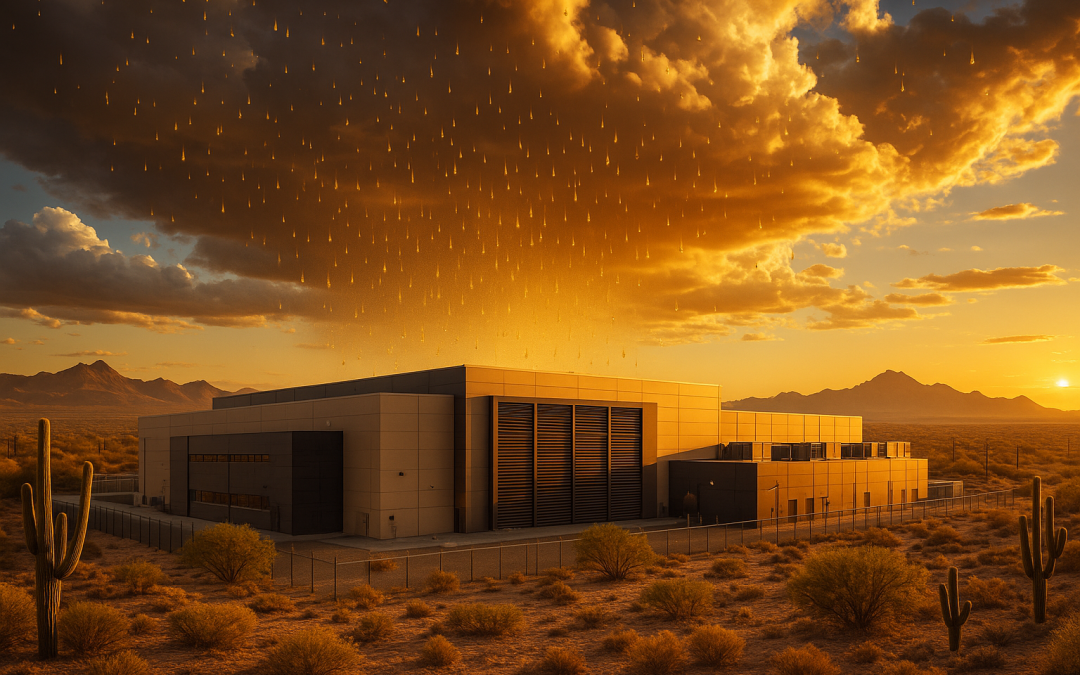A Hyperscale Data Center Gold Rush in the Southwest
Across the American Southwest, a boom in hyperscale data center construction is underway. Tech giants like Google , Microsoft , and Amazon are investing heavily in new campuses from Phoenix to Dallas, drawn by affordable land, tax incentives, and strategic network connectivity. In metro Phoenix alone, now the nation’s second-largest data center hub after Dallas, companies have built or planned over 700 megawatts of server capacity. Google recently broke ground on a billion-dollar data center campus in Mesa, Arizona, while Microsoft is expanding massive cloud server farms in Goodyear and El Mirage outside Phoenix. Amazon has also acquired land for new data center facilities to support its rapidly expanding regional cloud presence.
This surge in data center energy demand is fueled by the growth of cloud services and AI infrastructure, as compute-intensive workloads increasingly require more servers and power. However, all this digital infrastructure is colliding with a harsh reality: the Southwest’s extreme heat, water scarcity, and wildfire risks are putting unprecedented strain on the electric grid and raising serious resilience challenges.
Extreme Heatwaves Test Grid Reliability
Southwestern states are experiencing hotter summers and more intense heatwaves year after year. In Phoenix, temperatures can soar well above 110°F for days at a time during peak summer months. Such heat extremes drive up air conditioning usage and electricity demand across the region. Power grids are being pushed to new records; Arizona’s largest utility, APS, hit an all-time peak of over 8,500 megawatts during extreme temperatures, and Texas’s ERCOT grid is forecasting record-breaking summer peaks of nearly 88,000 megawatts.
Why are these records being shattered? A key factor is surging data center energy demand on top of rapid population growth and rising air conditioning usage. ERCOT officials note that data centers dedicated to cloud services and AI are the fastest-growing power consumers in Texas, expected to increase nearly tenfold by 2030. Similarly, Arizona’s utilities report that new industrial loads, especially large data centers, are major drivers of the anticipated 40 percent jump in peak electricity demand this decade. In short, heatwaves and data centers are a potent combination: hot weather spikes overall electricity usage, and data centers add a constant heavy load, further stressing grid capacity.
Prolonged heatwaves put electrical equipment under duress and can reduce the output of power plants and transformers. They also impair the efficiency of data center cooling systems. Record-setting heat has already caused data center outages elsewhere. In recent years, extreme heatwaves led to cooling failures, knocking major data centers offline. Extreme heat not only threatens data centers directly but also significantly strains the grid’s reliability, prompting regulators and utilities to be on high alert. Ensuring grid reliability in the Southwest during brutal summers has become a serious challenge, directly exacerbated by the energy appetite of sprawling data centers.
Drought and Water-Hungry Data Centers
It’s not only electricity these giant server farms consume; cooling data centers often requires enormous volumes of water, a growing concern in the drought-prone Southwest. Many facilities use evaporative cooling or chilled water systems, which can amount to millions of gallons of water per day across large campuses. Recent analyses estimated that data centers in the Phoenix area collectively withdraw millions of gallons daily for cooling purposes. While still a fraction compared to agriculture, this underscores data centers’ significant water use in an already arid environment.
Arizona has already taken drastic steps to safeguard water supplies, even limiting new home construction around Phoenix due to groundwater depletion concerns. The prospect of dozens more water-intensive data centers is causing additional concern. Communities are increasingly pressing for solutions. In suburban Phoenix, Microsoft faced pushback over water infrastructure requirements for its large campus in Goodyear. Initially planning water-intensive cooling, the company responded by agreeing to adopt air-cooled technology, significantly reducing water use and investing millions to help expand local wastewater treatment capacity. This kind of public-private partnership is becoming a model, as other operators explore water recycling, reclaimed water, and less water-intensive cooling methods.
Wildfire Threats and Grid Resilience
The Southwest’s changing climate also includes escalating wildfire dangers that impact grid operations and data center reliability. While Arizona, Nevada, New Mexico, and Texas don’t face California-scale wildfires, these states experience increasingly frequent wildfires capable of damaging transmission lines or prompting preventive power shutoffs. Utilities have had to de-energize certain lines during high-risk conditions, precisely when electricity demand is highest.
A significant wildfire event could knock out critical transmission infrastructure on a hot day, creating a nightmare scenario for grid operators. Data centers typically have backup generators and redundant power supplies, but extended outages strain even robust systems. Wildfires also create smoke and haze, reducing solar power output and compounding grid challenges. Ensuring grid reliability under compounded threats of fire, heat, and storms means hardening physical grid infrastructure and data centers against worst-case scenarios.
Planning Resilience: Utilities, Regulators, and Microgrid Solutions
The data center boom combined with extreme weather is prompting increased attention on energy resilience planning across the Southwest. Texas recently passed laws requiring large data centers to participate in emergency load reduction programs, potentially functioning as a giant safety valve for the grid during peak stress. Data centers are encouraged to invest in backup generation systems, offering demand-response services during crises.
In Arizona, utilities such as Arizona Public Service – APS and Salt River Project have plans to expand generation and transmission infrastructure significantly. With dozens of new data center projects in development, utilities have created specialized teams to coordinate infrastructure planning closely with developers. Data center firms are investing directly in renewable energy projects and microgrids, incorporating solar and battery storage solutions on-site to reduce reliance on the wider grid.
Microgrid solutions are gaining traction, allowing data centers to isolate themselves during emergencies, ensuring continuous operation despite external grid disruptions. Communities and local governments are also exploring innovative energy pricing structures and sustainability requirements to balance growth and resilience.
This intersection is precisely where expertise from firms like Mountain West Consulting, LLC (MWC) becomes invaluable. With significant experience in project management, microgrid planning, and resilient infrastructure, MWC helps bridge the gap between ambitious development goals and practical resilience solutions. MWC ensures that new campuses include built-in renewable generation, battery storage, and advanced energy management solutions, making them not only power-intensive but also smart about power usage.
Building a Resilient Digital Future
The Southwest’s data center expansion presents both opportunities and challenges. It drives economic growth, creates tech jobs, and builds essential digital infrastructure, but simultaneously compounds grid reliability, water scarcity, and climate resilience issues. Balancing data center energy demand with extreme weather risks requires proactive collaboration between tech firms, utilities, policymakers, and communities.
Fortunately, this collaborative planning has already begun from Texas’s grid reliability measures to Arizona’s expansive infrastructure investments. Innovative microgrid solutions and thoughtful planning are shaping a sustainable, resilient future. By combining robust engineering, strategic policy, and skilled project management, the Southwest can ensure its digital and energy future thrives amid growing climate uncertainty. The result: a robust digital ecosystem where data centers and communities succeed together!


Recent Comments